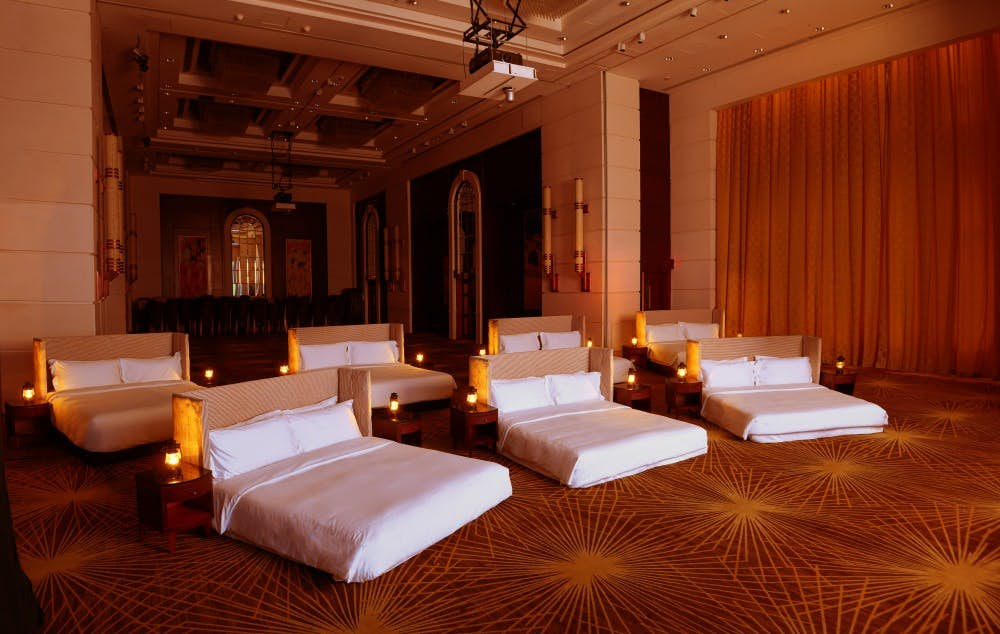Summer’s a great time to head to the great outdoors, but sunbathing, barbecues and picnics are too obvious to get those creative juices sizzling. There is a whole lot more to do than alfresco lazing and grazing. Seize some solar power and unleash an adventurous spirit with six team-building adventures worth embarking on in the summer sun.
1. Night cycling in Singapore

Where is it? Throughout Singapore’s city, coast and park areas.
What’s it like? Experience a different side of Singapore on two wheels! Night cycling is one of the Lion City’s favourite outdoor activities. Whilst you can certainly push those pedals during the day, you could be risking heat stroke or a traffic accident. Given Singapore’s humidity and rush-hour chaos, it’s not advisable. At night, however, it’s a whole different atmosphere – the sea breeze lifts that perspiration from your skin, street lights illuminate the quiet alleyways and there are significantly less vehicles on the road. Night cycling is also the perfect opportunity to burn those calories after that second sinful plate of delicious char kway tiao.
Why summer? Contrary to popular belief and at least one national song, Singapore’s not always a sunny island. Two monsoon seasons (December-March and June-September) might bless the island with cool showers each year, but the rains make for terrible cycling weather.
How are you going to do it? The lack of dedicated cycling lanes does not deter Singapore’s night cyclists, who can often be seen pedalling near the coastline in the left lane. If you are concerned about safety, Singapore is filled with many kilometres of Park Connectors that provide vehicle-free routes that go along canals and waterways. Watch out for those night joggers though!
What to bring: Although it’s not compulsory to wear helmets or safety equipment, doing so is highly recommended. In addition, it’s advised that all participants wear brightly coloured clothing and equip their bicycles with a safety light to increase visibility. Finally, a little bit of mosquito repellent will go a long way to ensuring your nocturnal bike ride is an enjoyable one.
Group size: The more the merrier.
Contact:www.nparks.gov.sg
2. Climb Mount Fuji

Where is it? Honshu Island, Japan.
What’s it like? With its snow-capped peak 3,776 metres above sea level, Mount Fuji might seem as daunting as Mount Everest. Whilst mountaineers risk their lives attempting to ascend the blisteringly cold slopes of the world’s highest peak, the trip to the top of Japan’s famous summit can be far less treacherous. In fact, it’s a feat that can be tackled by almost anyone and without the need for special equipment. Alongside the equally majestic Mount Tate and Mount Haku, Fuji has long been revered as one of Japan’s holy mountains. The climb to the top will make for many memorable and photo-worthy moments.
Why summer? Whilst temperatures may drop remarkably low near the top of the mountain, there is very little snow during July and August, the official climbing season. Outside of those two months, the possibility of snow makes the climb significantly more difficult, requiring mountaineering equipment and some level of experience.
How are you going to do it? There are four different routes up Mount Fuji, each with varying levels of difficulty. Unless your group is full of budding Sir Edmund Hillarys and Tenzing Norgays, the Lake Kawaguchi and Yoshidaguchi climbing routes are recommended. These are the most popular and have plenty of mountain huts which offer opportunities for respite along the way.
What to bring: Even though you might be in the sun, you probably won’t feel the heat once you’ve had your taste of cool mountain air. For maximum comfort, climbers should bring warm clothing, gloves and socks to keep warm. A hat or cap will be a useful shield from direct sun overhead, whilst a walking stick will be good for support. Equally important are sunglasses, sunscreen and at least 500ml of water. It’s important to travel light as the hike up can take several hours. Needless to say, those reaching for the summit should only bring what they need, so leave the laptops at the office.
Group size: Up to 12 people.
Contact:www.fujimountainguides.com
3. Hike the Overland Track

Where is it? Cradle Mountain, Tasmania, Australia.
What’s it like? The Overland Track is without doubt one of Australia’s most iconic and famous bush walks. The main route consists of 60 kilometres of pristine Tasmanian wilderness, but detours to attractions along the way extend it farther. The trek meanders past hulking mountains – including Tasmania’s highest, Mount Ossa – temperate forests, deep gorges and a variety of other terrains all part of the state’s World Heritage Wilderness Area. It might sound intimidating, but it’s an easy – if long – journey. Most hikers take around six days to complete the trail, and there are huts along the way that allow for plenty of breaks. In fact, a large percentage of those who follow the Overland Track are first-timers.
Why summer? Not only are the hours of daylight longer, but the vibrant alpine wildflowers will be in full bloom. Though the weather can be rather unpredictable, with snow and rain falling even in summer, it’s considered the best time to walk the track for the first time. Springtime is storm season in Tasmania, it can get uncomfortably damp in autumn, and in winter heavy snow may cover the trail markers so it is best left tackled by experienced hikers.
How are you going to do it? In addition to entry fees to Tasmania’s national parks, during the peak season from October 1 to May 31, a fee of A$200 (US$205) applies per adult walker.
What to bring: A packing list can be found at www.parks.tas.gov.au
Group size: Groups of up to eight people can sign up as independent walkers or join a tour with professional guides.
Contact: www.parks.tas.gov.au or
www.tasmanianexpeditions.com.au
4. Whitewater rafting in Malaysia

Where is it? Various waterways across Malaysia.
What’s it like? There are few water sports that bring adrenaline and nature together as perfectly as whitewater rafting. Participants should be braced to manoeuvre down gushing rivers and paddle for their lives against raging currents that run through the tropical rainforests. It’s no one-man show, however, this activity demands a high level of teamwork to ensure the raft moves in its intended direction instead of playing bumper-car with rocks. Despite the daunting description, thousands of people have successfully survived rafting each year, which is due in no small part to the expertise of well-trained river guides. As such, it is strongly advised to go with professionals for safety, proper equipment and training.
Why summer? There are two seasons in Malaysia – one wet, the other wetter. Whilst whitewater rafting can certainly be done in the monsoon season, novices might want to start modestly during the drier seasons between May and September. During these months the rivers are considerably less furious as rain can increase a river’s difficulty grade significantly.
How are you going to do it? Choose from a selection of waterways across the country, each with varying grades of difficulty ranging from one to six. One is perfect for beginners, whilst six is described as “significantly life threatening” and navigation “virtually impossible” – best avoided by novices.
Group size: Between four and 12 people per raft.
Contact: www.mmadventure.com
5. Climb the Great Wall of China

Where is it? Sections of the Great Wall near Beijing.
What’s it like? The Great Wall of China is one of the most visited destinations in the Middle Kingdom, yet few visitors have made their way to its more rugged, unrestored sections. These sections of the Wall are hidden from the public eye or, at the very least, are not accessible by the ubiquitous tourist coach. “Great Wall Hiking” is a specialist tour group that thinks visitors to the Wall should truly experience what makes it great.
Those who embark on this odyssey will do so with experienced guides, camping overnight on this man-made wonder that snakes its way across hills, highlands and the harsh wilderness that has remained relatively unchanged for much of the millennium. Visitors will experience iconic sections of the wall such as Gubeikou, Jiankou and Lalongtou – literally Old Dragon’s Head – where the Great Wall actually extends to the sea, much like a dragon drinking water. Finally, there’s still other majestic ruins of ancient Chinese civilisation – from the Summer Palace to the Forbidden City and the Temple of Heaven – to marvel at when you finally head back to the city.
Why summer? April to October is warm and an excellent time to be camping without facing the cold of the other seasons. It is also the most popular time of the year to visit the Great Wall.
How are you going to do it? “Great Wall Hiking” offers hikes, treks and expeditions that span one to12 days. Keep in mind that walking
on the unrestored sections of the wall can be physically challenging and far from modern amenities, so the group’s fitness level has to
be considered.
Group size: From one to 65 people.
Contact:www.greatwalladventure.com
6. Motorcycle tours in Vietnam

Where is it? Central Vietnam.
What’s it like? If cycling, hiking and trekking sound too physically demanding, minimise the footwork with the help of a motorcycle. Leave tourist traps and cookie-cutter T-shirt attractions in the dust and take the high road to another side of Vietnam. Ride on lanes that weave through lush mountains and remote villages where farmers tend their rice fields, playful children still walk to school and livestock epitomise the meaning of “free range”. When tired, body and soul can be recharged at one of the modest local hotels and guesthouses along the route. Bikers are accompanied by guides who will introduce participants to the culture of some of the 54 minority groups that still exist in Vietnam. Guides will also ensure rider safety and make sure groups do not get lost in the lush wilderness.
Why summer? Warmth from the sun will negate the chilly air when riding through the Central Highlands, home of several hill tribes and villages. For those looking to travel to other parts of Vietnam, the climate differs: the North has hot and humid summers from May to August, whilst the South has a dry season from December to June.
How are you going to do it? All riders must possess a riding licence. Not having one does not mean you cannot come along, it just means you get to ride pillion.
Group size: Two to eight people per guide.
Contact: www.vietnammotorcycletrips.com


